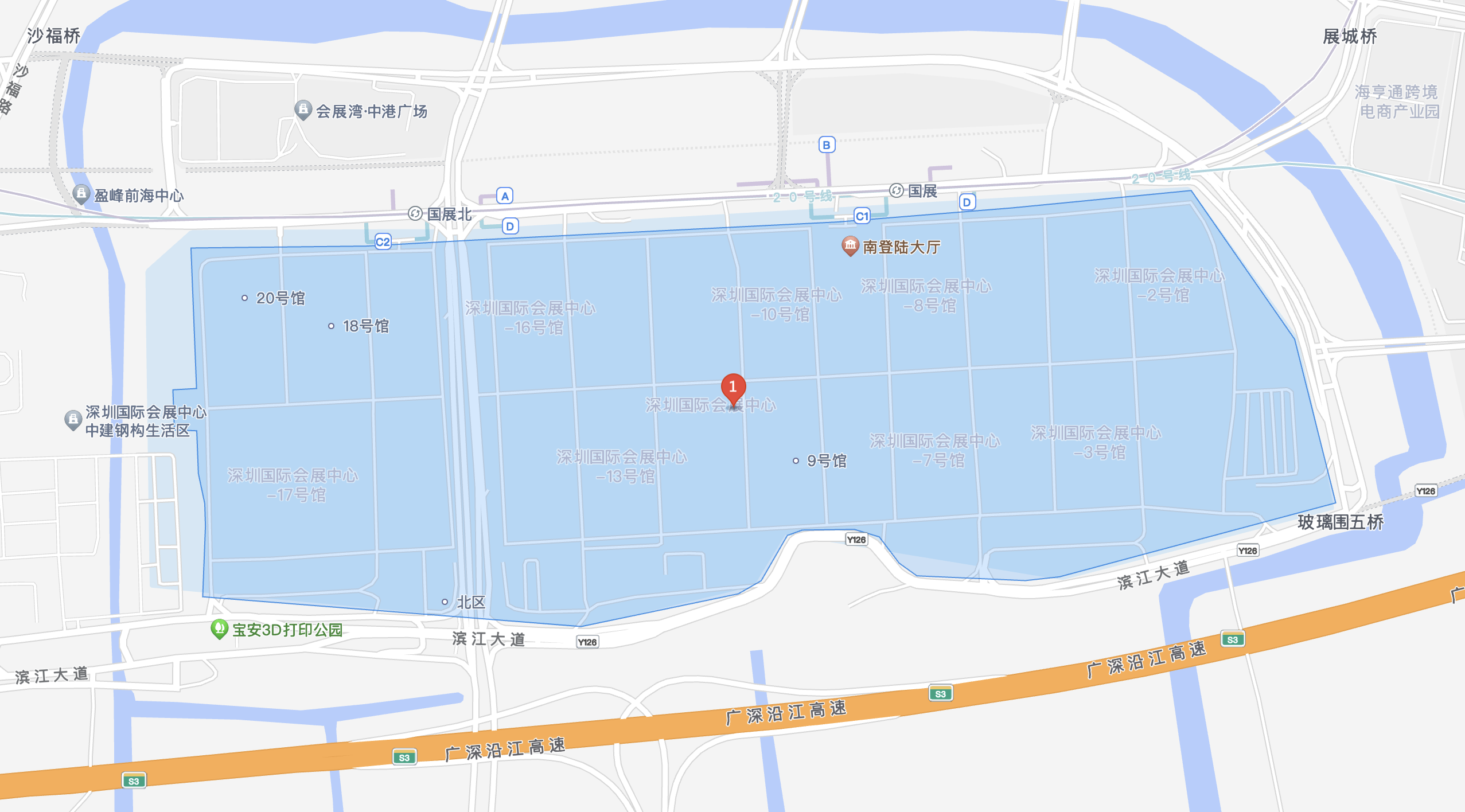

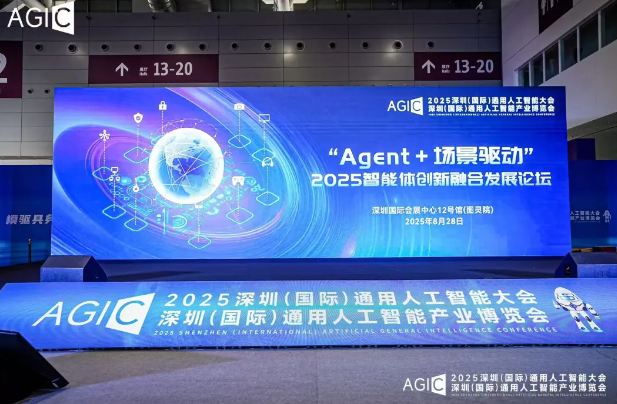
On August 28, 2025, the "Agent + Scenario-Driven" 2025 Intelligent Agent Innovation and Integration Development Forum was grandly held at the Turing Academy in Hall 12 of the Shenzhen International Convention and Exhibition Center (Bao'an). Hosted by the Shenzhen Artificial Intelligence Industry Association, the forum aims to bring together industry experts to discuss in-depth the innovative applications and integrated development trends of intelligent agents in multiple scenarios.
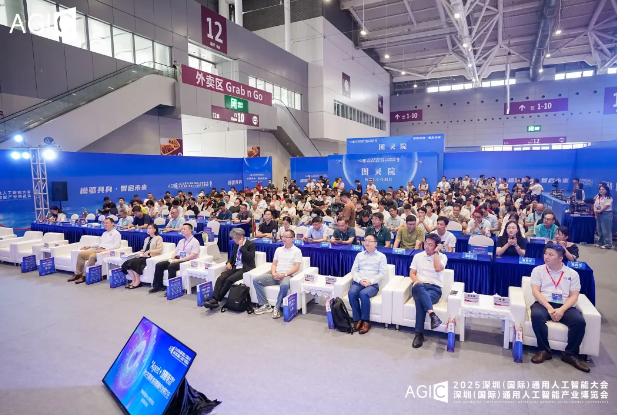
The forum officially opened at 2:00 PM. Yang Ailin, Executive Director of the Sun Yat-sen University Shenzhen Research Institute, delivered a leadership speech. She pointed out that artificial intelligence is the most transformative force today, and intelligent agents, as a key breakthrough in the AI field, have moved from theory to practical application, leveraging large-scale model technology. They have widely penetrated industrial manufacturing, smart cars, cross-border e-commerce, and other fields, contributing to efficiency improvements and cost reductions. She also highlighted three major challenges facing intelligent agents: technology (reasoning/decision-making/stability), application (scenario integration/compatibility), and ethical and legal (privacy/data security/liability), emphasizing the need for coordinated responses from government, industry, academia, research, and application. Yang Ailin also introduced that Sun Yat-sen University's AI disciplines rank among the top in China. The Shenzhen Research Institute will deepen AI talent development and promote industry-university-research collaboration to advance the development of intelligent agents. She hopes the forum will foster exchange and help intelligent agents contribute more to the development of human society.
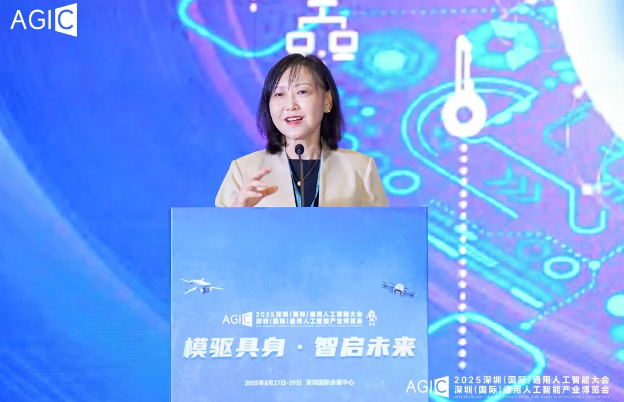
Wei Tianyu, Rotating President of the Shenzhen Artificial Intelligence Industry Association, then delivered a speech. He stated that AI has evolved from perceptual intelligence to cognitive intelligence. Intelligent agents, leveraging their "thinking + action" capabilities, have achieved a breakthrough from "talking well" to "acting well." They are capable of handling tasks such as ticket booking, dispatching orders, and industrial production processes, addressing the shortcomings of traditional large models. He also explained that Shenzhen, as a core city for AI innovation, has established a complete ecosystem from "technical research" to "industrial implementation." The association will continue to focus on agent technology research and promote the implementation of scenarios such as "AI + Ocean," "AI + Manufacturing," and "AI + People's Livelihood." He also wished the forum a great success.
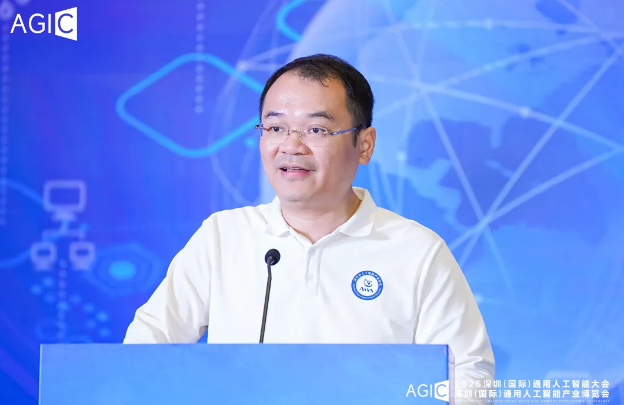
During the expert presentation session, Fan Xun, Foreign Academician of the Russian Academy of Engineering and Professor at the University of Electronic Science and Technology of China, shared his views on "The Future of Embodied Intelligent Machines." He believes that artificial intelligence has become the core driving force of a new round of industrial transformation. In response to the current situation of insufficient forward design capabilities for domestic EDA tools and industrial robots amid the Sino-US "chip war," he is focusing on researching the "limb-brain-eye" design automation of intelligent robots under embodied intelligence. He has developed robots for pressure leak plugging and road crack detection, and has proposed lightweight networking and modular design automation. In the future, he will promote the development of self-evolving embodied agents, achieving a collaborative "embodied intelligence (EI) - self-evolving agents (SEA) - modular design automation (MODENA)" approach.
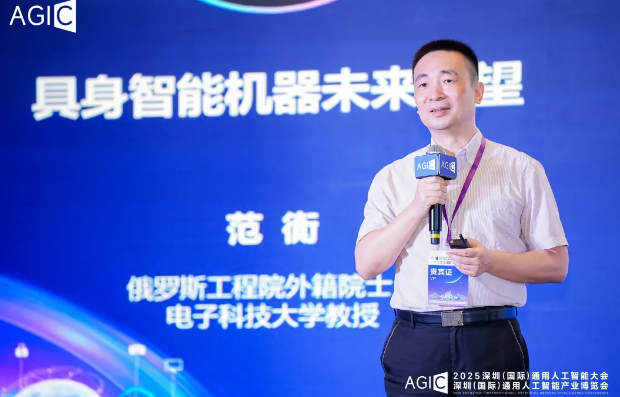
Japanese AGI expert, Representative Director of the Whole Brain Architecture Initiative (WBAI), and former Chairman of the Japan Society for Artificial Intelligence, Hiroshi Yamakawa, proposed the core theme of "The Great Shift: From Competitive Civilization to Symbiotic Civilization." He pointed out that the period of rapid expansion of AI intelligence from 2025 to 2030 will be a critical turning point for human civilization. He explored the development of artificial intelligence using the WBA (Whole Brain Architecture) approach (first developing machine learning modules in the brain, then integrating them to build human-like artificial general intelligence). He also warned of three risks: misuse, malicious use, and betrayal. The latter could lead to the loss of control of weapons or infrastructure that humans cannot resist. Based on predictions of the AI singularity, he proposed a three-tiered defense system: the AIS (AI Immune System), EME (Emergent Machine Ethics), and IBRF (Integrated Betrayal Risk Framework) to promote a paradigm shift in civilization. Ultimately, the "Declaration of Intelligent Symbiosis" advocates for the symbiosis of humans with diverse intelligences, including AI, to achieve long-term sustainability.
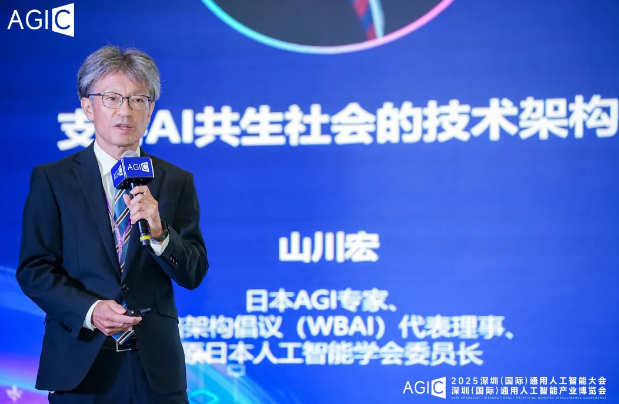
Zhong Chao, CEO of Basic Operations (Shenzhen) Technology Co., Ltd., focused on "The Ecological Transformation and Future Possibilities of the Fashion Industry in the AI Era." The company's LOOK AI is an AI tool developed specifically for the fashion design field, aiming to address the pain points of traditional fashion design, including slow processes, intensive communication, long development cycles, high trial-and-error costs, and the suppression of creative ideas. Leveraging data feedback from nearly 100,000 professional designers and a database of tens of millions of popular fashion images, LOOK AI has built a "fashion trend model" (updated weekly, with rapid user and database growth). This model offers AI-powered real-time design, style graphics and AI-powered renderings (direct reading by pattern designers), material conversion, AI-generated body graphics/virtual models, and intelligent face and scene swapping. This reduces development cycles by 30-50%, designer drawing time by 80%, and photoshoot costs by 70%. LOOK AI is positioned as an "assistant designer," helping to reshape the fashion design system rather than replacing human designers.
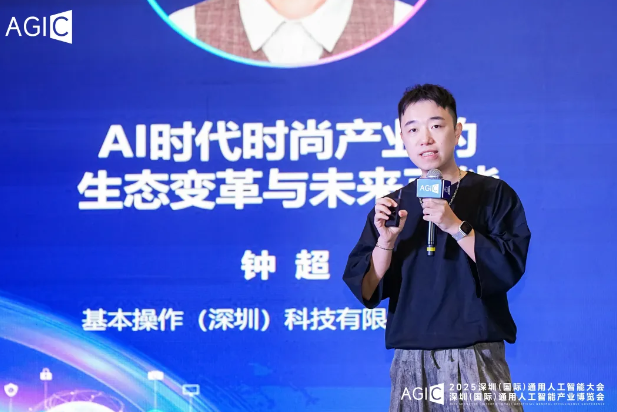
Sun Lecheng, Chief AI Officer of Shenzhen Netsin Synaptics Software Co., Ltd., introduced "Data Intelligence: An Agent Solution for Enterprise Management Decision-Making." Netsin Synaptics' Data Intelligence solution for intelligent enterprise management decision-making is designed to empower executives to achieve strategic, financial, and operational excellence. This solution addresses the five major challenges facing enterprise decision-making in the era of data explosion (data silos, delayed reporting, data deluge, shallow data mining, and complex decision-making). Leveraging four intelligent engines—data-driven, knowledge-driven, network-driven, and deep analysis—and leveraging Agentic AI as its core technical architecture, it can complete decision analysis that would traditionally take two weeks in just 10 minutes. The implemented product, "Xinsiwenshu," boasts precision, comprehensiveness, depth, and security, supporting zero-code adaptation across all industries. Its commitment to "trusted, controllable, and evolvable" technology and a four-stage implementation framework ensure enterprise implementation.

Xiao Jianzhang, CEO of Shenzhen Community Cloud Technology Service Co., Ltd., presented "Community Service Intelligent Body: Innovative Practices in 'AI+SaaS' Property Management." He proposed using the Community Service Intelligent Body to drive innovative practices in "AI+SaaS" property management. The initiative focuses on the inflection point in community service development (from industrial civilization to intelligent industry civilization, emphasizing "No Cloud, No AI," with data as the foundation of AI). Using "Know Cloud, Know AI," it builds a foundation of "computing power + algorithms + data calculation." Following a three-step approach of "digitalization - digital intelligence - digital governance," combined with the "four degrees, four transformations, and four full-staff" operational elements, it implements various intelligent agents (such as quality agents and energy management agents) at both the community and enterprise levels. Using a 20-year-old community as an example, the initiative has achieved staff optimization (reducing the number of environmental stewards from 15 to 6, plus smart terminals), improved efficiency (a 15% increase in collection rates), and reduced costs (a 60% reduction in quality inspection costs), ultimately shifting community services from labor-intensive to technology- and knowledge-based.
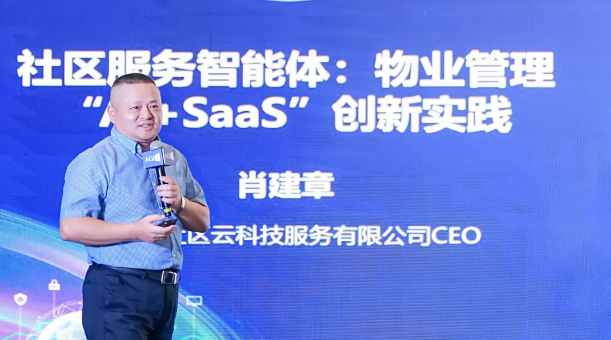
Huang Deqiang, Chairman of Shenzhen Dashi Qiyun Health Technology Co., Ltd., shared his company's development history, discussing the application of medical big data and agents in proactive health. Dashi Qiyun pioneered the launch of AI management brains and AI patient services. Its business has evolved from traditional medical IT (1.0) to healthcare big data (2.0) to big model/AI applications (3.0). Its core strengths include DCMM-level 3 data governance capabilities, multimodal data fusion technology (based on 26 years of imaging data accumulation), AI patient services based on the DeepSeek big model (with semantic understanding accuracy exceeding 95%), and "cloud + AI" imaging products. It has currently implemented 10 city-level healthcare big data platforms (covering 50 million people and cleaning 20.4 billion data records), serving six of China's top ten hospitals and over 400 Class A hospitals. Its mission is to make health technology accessible to everyone, and its vision is to become a leading health technology company in China.
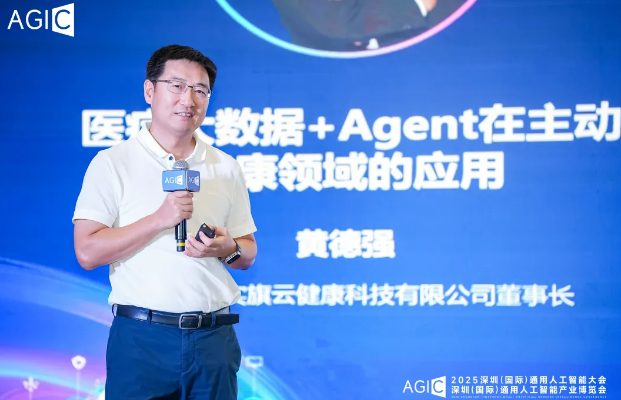
Duan Xiaowei, Director of the Science and Technology Exchange Department of the Shenzhen Municipal Ocean Development Bureau, delivered a speech titled "Accelerating the Development of AI + Ocean Application Scenarios and Empowering High-Quality Development of the Marine Economy." He stated that as a strategic technology leading the new round of scientific and technological revolution and industrial transformation, AI is deeply integrated with the marine economy, which is at the heart of China's modernization. Shenzhen shoulders the mission of building a global marine hub city. Shenzhen's marine GDP is expected to reach 540.94 billion yuan in 2024. The city is currently focusing on three key areas: AI + marine business (planning management, law enforcement, economic analysis, etc.), AI + marine industry (unmanned intelligent transformation, including deep-sea resource development, port shipping, etc.), and AI + marine services (disaster forecasting, ecological early warning, etc.). By improving marine data governance, integrating AI marine computing power and large models, and building a digital twin foundation, Shenzhen will promote the development of advantageous land-based industries offshore and facilitate the digital transformation of the marine economy.
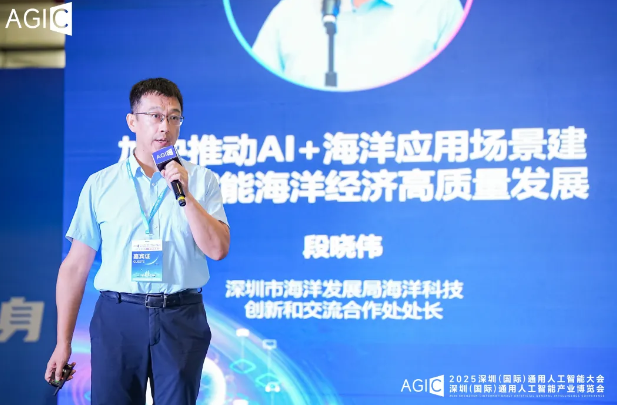
Afterwards, Ke Shuisong, Deputy Director of the Shenzhen Planning and Natural Resources Data Management Center, launched the theme scenario of "A Unified Spatiotemporal Digital Foundation for Land and Sea Coordination and Marine Public Services." He proposed focusing on the major strategic task of building a strong maritime nation and the overlapping opportunities presented by multiple national strategies, including Shenzhen's pilot demonstration area for socialism with Chinese characteristics, the Guangdong-Hong Kong-Macao Greater Bay Area, and its role as a global maritime hub. He proposed driving the high-end, intelligent, and green transformation of the marine industry with new technologies, centered on "AI+" and "unmanned+." He also proposed exploring the construction of a unified spatiotemporal digital foundation and application ecosystem that integrates land and sea. This foundation encompasses three core capabilities: real-world, three-dimensional, spatiotemporal data resources covering the entire city; AI infrastructure leveraging multi-channel computing power and a hybrid large-scale model framework; and IoT-connected sensing resources from a three-dimensional observation network covering land, sea, air, and space. It will implement four application services: "Foundation + Bay Area," "Foundation + Low-Altitude Economy," "Foundation + Decision Support," and "Foundation + Marine Observation and Forecasting." Through a collaborative model among government, businesses, and research institutions, this will support the high-quality development of the marine industry and provide a "Shenzhen model" for the strategy of building a strong maritime nation.
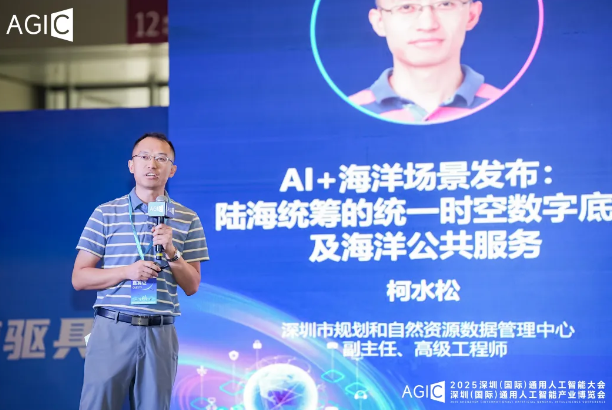
Hu Wei, Senior Manager of the Digital Intelligence Center at China Merchants Port Group, unveiled the "Port Scheduling Big Model and Port Machinery Intelligent Big Model." Leveraging these two core technologies, the project focuses on intelligent upgrades across the entire port operations chain, encompassing five key areas: equipment management, terminal operations, damage identification, document processing, and tally counting. The goal is to achieve three key benefits through AI: cost reduction and efficiency improvement, industry benchmarking, and digital transformation.
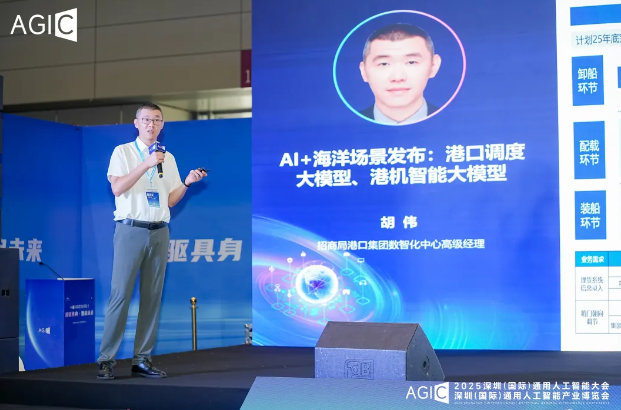
Gou Peng, Senior Engineer at Shenzhen Intelligent Offshore Engineering Innovation Center Co., Ltd., delivered a presentation on the application of AI throughout the lifecycle of offshore engineering equipment. He pointed out that offshore equipment is characterized by long lifecycles (decades), high costs, and significant risks. These include technical complexity, reliance on expert R&D expertise, and significant construction and maintenance challenges. AI can deeply empower the four major phases of R&D, design, construction, and operation and maintenance through intelligent knowledge bases, generative solution design, intelligent welding monitoring, and remote unmanned operation and maintenance. He also envisioned the future of large-scale model-driven decision-making, the integration of AI and digital twins, and unmanned operations and maintenance, emphasizing their strategic significance for driving the intelligent transformation of the offshore equipment industry and enhancing my country's global competitiveness in this sector.

Finally, a summary and group photo session of the AI+ Ocean Scenario press conference brought the forum to a successful conclusion.
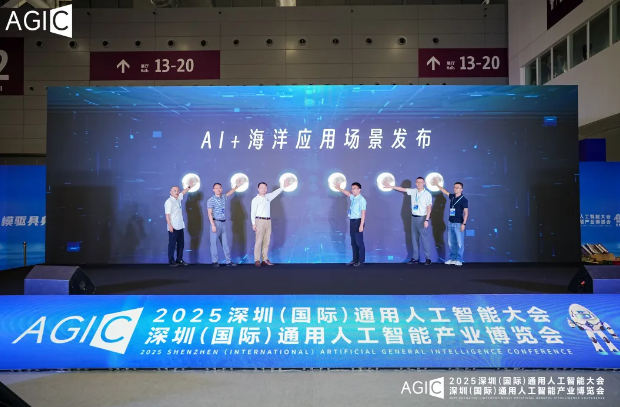
The forum featured a high-profile panel of leading experts and scholars in the field of intelligent agents, as well as decision-makers and technical leaders from leading companies. The participants engaged in in-depth discussions on the evolution of core intelligent agent technologies and innovative applications across multiple scenarios. The agenda covered cutting-edge AI technologies, the practical implementation of industry solutions, and other topics, closely aligned with industry trends. This approach fully demonstrated both academic foresight and practical guidance, providing an important exchange platform for promoting the integrated development of intelligent agent technology innovation and the industrial ecosystem, and is of great significance to the future development of the industry.
This paper is from Ulink Media, Shenzhen, China, the organizer of IOTE EXPO (IoT Expo in China)













